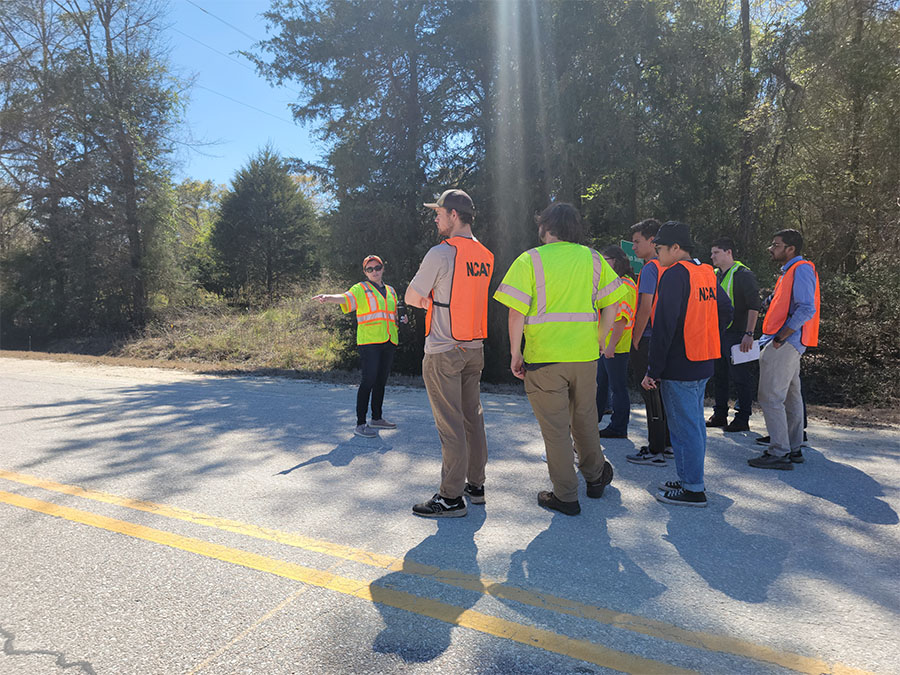- Spring 2023
Teaching Pavement Preservation in the Classroom
Conveying the importance and positive impact of proper pavement preservation is vital when teaching students. Both Dr. Adriana Vargas at Auburn University and Dr. Andrew Braham at the University of Arkansas use free, online tools to help students understand the power of pavement preservation.
Since 2017, Dr. Vargas has been teaching the graduate-level Pavement Management and Rehabilitation course. Pavement preservation is one of the course modules, where students are introduced to the different treatments available, from crack sealing to thin overlays, and where they learn how to properly select from various options based on existing pavement condition and cost-effectiveness. For most students, this is an introduction to these treatments, and understanding the processes and impact on a pavement is not always intuitive. Fortunately, NCAT offers a unique opportunity to these graduate students (and anyone else interested in pavement preservation). Only five minutes away from NCAT’s main office is a half-mile research study on Lee Road 159 constructed as part of the Pavement Preservation Group (PG) Study, which gives visitors a chance to walk on 25 distinct test sections, see what the treatments look like, and observe the long-term performance and benefits from each.

In addition to the field visit, students have access ten years' worth of performance data for the test sections through an online tool on NCAT’s website, developed to provide research results to the public in a user-friendly format. The tool provides pre-treatment, post-construction, and current condition values for three key performance indicators (cracking, rutting, and smoothness), as well as performance curves based on pre-treatment condition, pictures, and treatment details. This information can also be used for the course’s final project, where students work in groups to implement a pavement management system using a training database. Part of the assignment consists of developing decision trees to help guide an agency through its project selection process. With the help of Lee Road 159’s real world data, students have a better understanding of treatment applicability and expectations under different scenarios. At the end of the semester, students present their work as if they were talking to elected officials. Developing the skills to reach the right audience, while demonstrating a sound technical position, is critical for future professionals.
Dr. Andrew Braham also leverages the observed performance data from NCAT’s pavement preservation sections on Lee Road 159, where he uses the data at the end of a semester-long, 3-part class project. The class, CVEG 4423: Transportation Infrastructure, is a required, senior-level undergraduate class. The first and second part of the project uses RoadResource.org. RoadResouce.org has comprehensive information on many types of asphalt emulsion-based pavement maintenance and pavement rehabilitation treatments. In addition, there are four calculators available where data from local agencies can be input in order to explore the behavior of the various treatments. For his class, traffic level, lane miles, existing pavement condition, and budget from the Arkansas Department of Transportation are used as inputs for two of the calculators: life cycle cost and remaining service life. In short, the class is divided into groups, where each group is assigned one maintenance treatment and one rehabilitation treatment. In the first half of the class, students get a sense that, in theory, pavement maintenance treatments may not last as long as rehabilitation treatments, but over the life span of a pavement they actually cost less money. In addition, the students find that all maintenance treatments increase the overall condition of a pavement network over time, whereas all but two rehabilitation treatments decrease the overall condition of a pavement network over time. In fact, one of the comments from a student after the project was “Pavement preservation has the ability to provide direct, cost saving, and innovative, solutions to the varying issues within the 37,232 lane miles of highway network in Arkansas.”

While these first two parts of the class project clearly demonstrate the benefits of proactive maintenance over reactive rehabilitation, they are idealized, as it is never recommended to put one single treatment on an entire network. In addition, the calculators on RoadResource.org use national-level averages for concepts such as price and life extension and assume that the treatments are being put down on a road in the proper condition for the treatment. Therefore, the data from Lee Road 159 provides a perfect platform for the third project. The students already understand the basics of the different types of treatments, and now they can analyze real data, from a real road, with real traffic, where the treatments were put on roads of varying conditions. While in general, treatments performed better when placed on the sections that were in good condition, there are of course exceptions in the “real world”. This helps the students understand that while many of the concepts of pavement preservation hold true, there are of course always exceptions. Overall, the best part of this semester-long project is that by the time we get to the end of the semester, and we actually talk about pavement preservation, maintenance, and rehabilitation in class, the students have a working knowledge of these topics, so instead of them simply writing down what is said in class, there is a robust discussion of the concepts.
As pavement preservation becomes a greater priority for agencies looking to maximize cost-effectiveness, educators must adapt to prepare the next generation of pavement engineers. Going beyond traditional academic lectures and examples brings students closer to the real world. Leveraging the results from a long-term research effort to teach these concepts is one of the many contributions of the PG Study to help improve the quality of our pavement networks.


Contact Andrew Braham or Adriana Vargas for more information about this article.